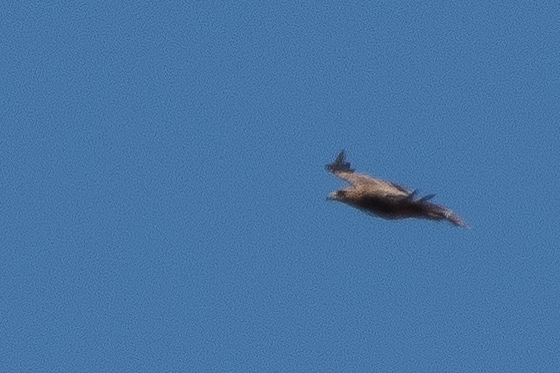An Eastern Imperial Eagle (Aquila heliaca) was photographed in spring 2017 at El Haouaria, northern Tunisia (Mohamed El Golli). El Haouaria, located at the extreme north-east of the Cap Bon peninsula, is known as a major point for migratory raptors following the Central Mediterranean Flyway (continental Italy-Sicily-Tunisia). In our opinion, this is the first record of the Eastern Imperial Eagle for Tunisia. It’s also the first record for Northwest Africa as a whole: no previous records exist for both Algeria and Morocco.
In an article about “New bird records in Tunisia (2005-2014)”, Hichem Azafzaf and his co-authors (2015) mentioned “the observation of a radio-tracked individual born in Hungary in 2012 and photographed in November 2013 on the island of Pantelleria (east of Cape Bon)”. They added that this “suggests that the bird joined this island from Cape Bon, Tunisia”. They also added “this same individual had previously entered Africa through Libya, coming from Greece, before continuing toward Ghana (where its transmitter broke down) and returned via Burkina Faso and Niger (BirdLife Hungary, M. Prommer)”. Here is the full quote in French:
« L’observation d’un individu radio-pisté né en Hongrie en 2012 et photographié en novembre 2013 sur l’île de Pantelleria (à l’Est du Cap Bon) laisse penser que celui-ci a rejoint cette île à partir du Cap Bon en Tunisie. Ce même individu avait préalablement pénétré en Afrique par la Libye en provenance de Grèce pour se rendre ensuite au Ghana (où son émetteur est tombé en panne) et revenir par le Burkina Faso et le Niger (BirdLife Hungary, M. Prommer) ».
Based on this bird, Azafzaf et al. (2015) wrote that the Eastern Imperial Eagle could be added as a new species for Tunisie.
As you can read above, there is nothing in the text that indicates that the bird has touched or flown-over Tunisia. We would like to hear what the readers think. Are observations like this one sufficient to add a new species to the national list of the country? Thank you!
Reference:
Azafzaf, H., Feltrup-Azafzaf, C., Dlensi, H. & Isenmann, P. 2015. Nouvelles données sur l’avifaune de Tunisie (2005-2014). Alauda 83: 7-28.
Thanks to Mohamed El Golli for the photographs and information. Thanks also to Mohamed-Ali Dakhli for initiating the discussion about this eagle.
The author of the record is considering the publication of a short note detailing this observation.


Votre observation est vraiment une preuve indubitable : bravo ! Nos spéculations à partir de l’oiseau de Pantelleria indiquent tout juste que l’oiseau est sorti quelque part d’Afrique, mais où ? Cap Bon, peut être !
C’est tout ce que nous voulions dire.
Merci Mr Paul Isenmann pour votre réponse, justement d’après les publications de M. Horvath et M. Prommer faites en 2013, il n’était mentionné nulle part que l’oiseau était passé par la Tunisie, donc il s’agissait bien d’une simple hypothèse, nous voulions en être sûrs.
Merci à vous deux pour la discussion!
Complément à mon précédent mail : L’individu né en 2012 en Hongrie a été repéré sur Pantelleria en novembre 2013, il a pénétré en Afrique du Nord à l’été ou l’automne 2012 (en venant de Grèce) par la Cyrénaïque en Libye pour se rendre au Ghana, puis le Burkina Faso et le Niger… (et enfin Pantelleria).
Dear All,
The eastern imperial eagle (called “Gabi”) referred in the text was tagged by us on behalf of MME BirdLife Hungary in 2012 . The bird crossed the sea and the Sahara in a route through Greece-Libya-Algeria-Niger-Mali-Burkina Faso-Togo-Ghana. See this link for the map: https://www.satellitetracking.eu/inds/showmap/?check_74=74
The tag of the bird went wrong in Ghana and the latter data from Pantelleria and Hungary were based on two observations of the individual. So even if it was much more probable that the bird went to Pantelleria through Tunisia than from any other African country, but we cannot prove it. So this case worth to mention, but definitely that was not the 1st proven case.
Best regards,
————————————-
Marton HORVATH, PhD
species conservation manager, MME BirdLife Hungary
http://www.imperialeagle.eu
https://www.researchgate.net/profile/Marton-Horvath-4
http://www.facebook.com/PannonEagleLife
Hi Marton,
Thank you very the detailed comment!
We read that the bird was observed at Pantelleria in November, so we logically thought that it was migrating southward at that time (because, as you know, this month is generally associated with autumn migration in the northern hemisphere). But apparently, the published information quoted in the blog-post was not complete.
I searched ‘Gabi Pantelleria’ and learned that the bird was first observed at Pantelleria in April 2013 and spent the summer and autumn in the island until October. Now this makes more sense: the bird entered Pantelleria during spring (northward) migration, so it’s most likely crossed from Tunisia.
Thanks again!
Mohamed
Thanks Mohamed for further clarification, and sorry that if forgot to write exact dates:
last satellite-tag signal from Ghana: 23/01/2013
observations in Pantelleria (which were sent to me): 09/04/2013 – 06/10/2013
observation in Hungary: 30/04/2014
Best regards,
Marton
Hello,
I first found and photographed the satellite-tracked eagle in Pantelleria, and followed the bird for three months there. When I spotted the eagle, it was coming directly form Cap Bon, which was clearly visible from the top of Pantelleria Island.